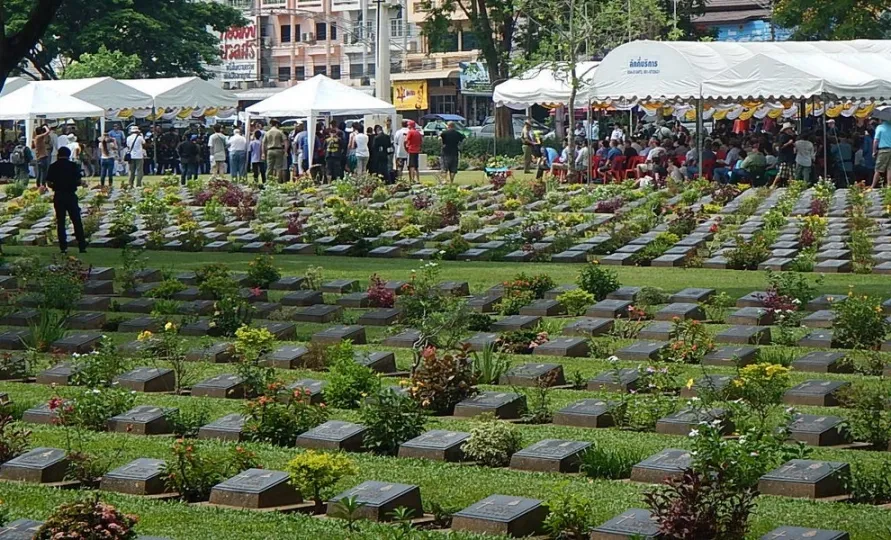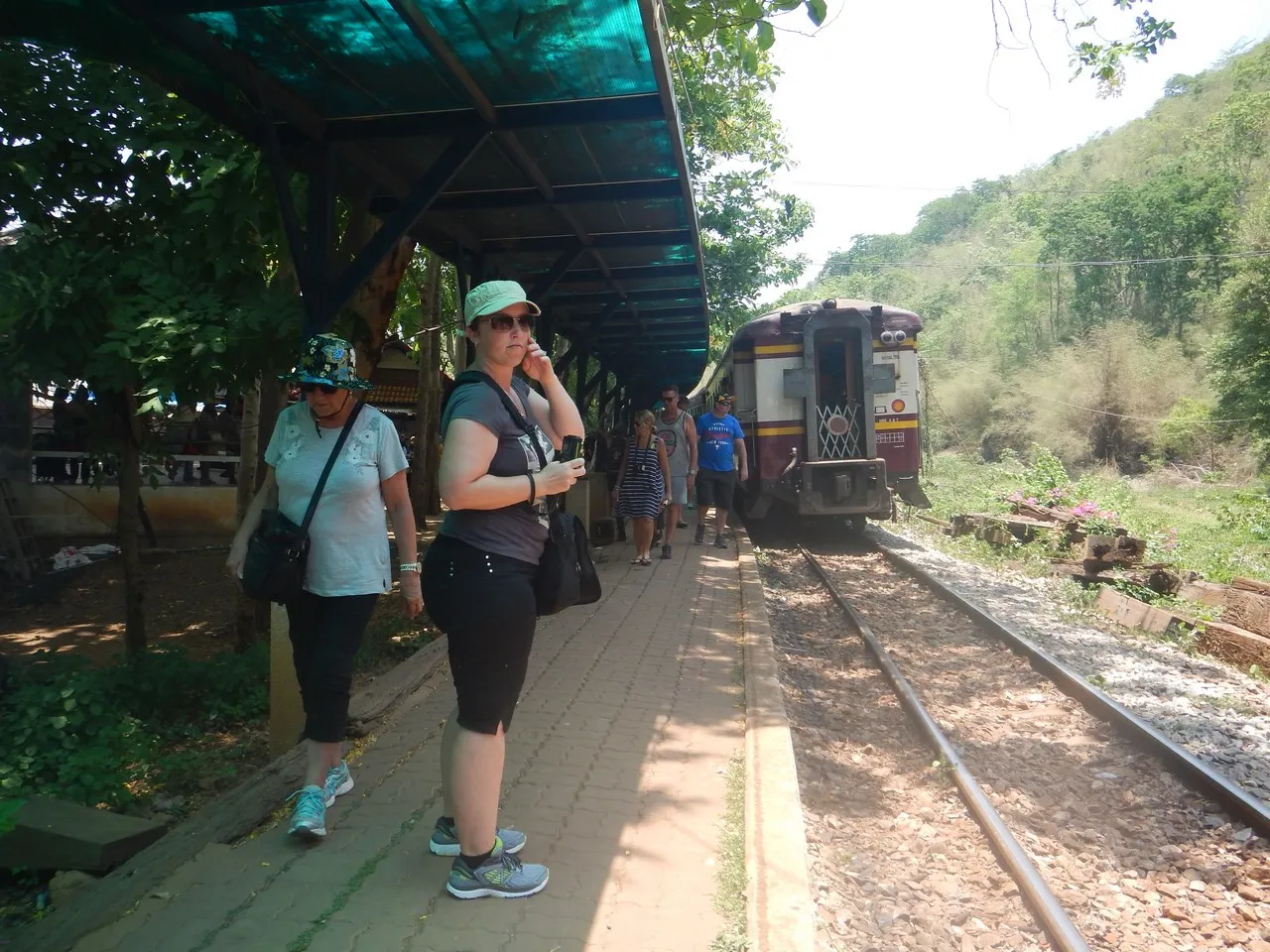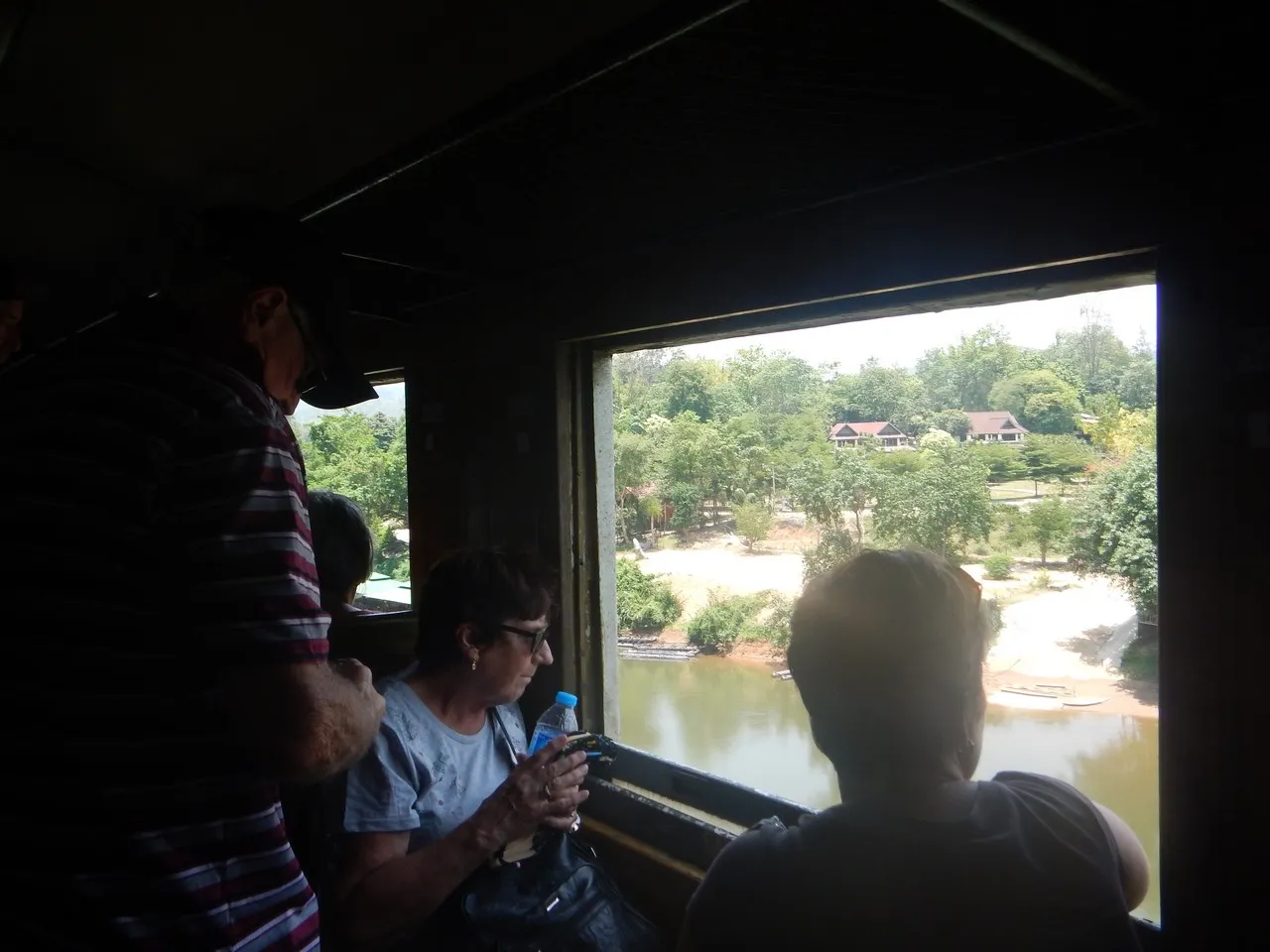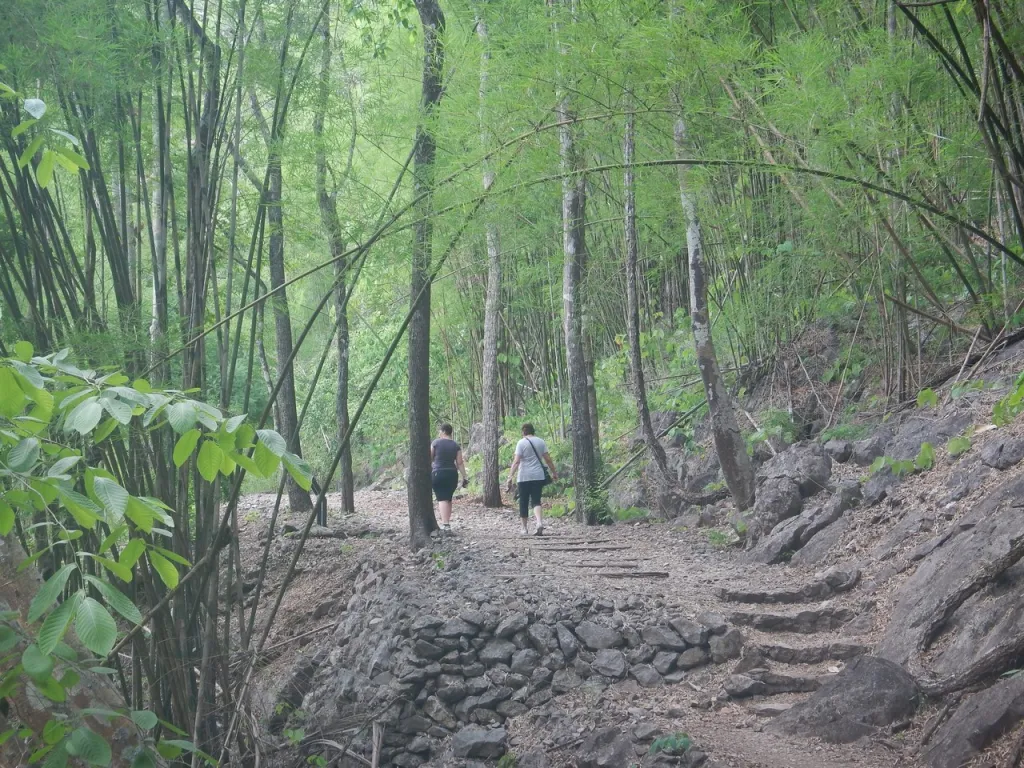
Attractions information
Don Rak War Cemetery Kanchanaburi
The Don Rak War Cemetery in Kanchanaburi is the final resting place of 6,982 Allied POWs who perished during the construction of the Death Railway during World War II.
There is another cemetery at Chungkai just outside Kanchanaburi.
Don Rak War Cemetery in Kanchanaburi is maintained in beautiful condition by the Australian Government and is a sober reminder of those who paid the supreme sacrifice so that we could live in peace.
The Kanchanaburi War Cemetery is only a short distance from the site of the former 'Kanburi', the prisoner of war base camp through which most of the prisoners passed on their way to other camps.
The graves are marked with horizontal bronze plaques set into the grass. Scarlet, purple and white bougainvillaea tumbles over the surrounding walls and flowering trees and shrubs dot the grounds. It seems a strange thing to say, but this is truly a beautiful place.
Within the entrance building to the cemetery will be found the Kanchanaburi Memorial, recording the names of eleven men of the army of undivided India buried in Muslim cemeteries in Thailand, where their graves could not be maintained.
The Don Rak War Cemetery is the location of the ANZAC Day Wreath-laying Ceremony held on 25th April each year.
Important Information
On wet days, the lawn cemetery is off-limits to the public.
If you wish to see a specific grave, please bring the number with you as there are two main cemeteries in Kanchanaburi.

Attractions information
Bridge over the River Kwai
The Bridge over the River Kwai was built during World War II for the Japanese Army using Allied POWs.
Altogether, 61,700 British, American, Australian, Dutch and New Zealand soldiers and a large number of Chinese, Vietnamese, Japanese, Malaysian, Thai, Burmese and Indian labourers were involved.
Two bridges were actually built side by side. A wooden trestle bridge, which is no longer there, was completed in February 1943 and an eleven span steel bridge completed in April 1943.
This bridge had been dismantled by the Japanese and brought to Kanchanaburi from Java in 1942. The central spans were destroyed by Allied bombings and rebuilt by British Army Engineers immediately after the war.
It was part of the strategic railway linking Thailand with Burma. During the construction of the bridge over the Khwae Yai River - River Kwai as it is known among foreigners - the brutalities of war, disease and starvation claimed thousands of POWs lives.
The bridge was immortalised in the book by Pierre Boulle entitled The Bridge Over The River Kwai and later in the movie of the same name. Unfortunately, he had never been to Kanchanaburi or he would have known that the railway does not cross the River Kwai. It actually crosses the Mae Klong River, so the Thai authorities simply renamed the river to aid tourism!

Attractions information
Death Railway Wang Pho Viaduct
The Death Railway is a section of the Thai-Burma line which was built to support the Japanese occupation of Burma during World War 2. The Wang Po Viaduct is a wooden lattice structure that supports the railway line around a cliff wall with the River Kwai below and is quite spectacular.
The twice-daily train service runs from Thonburi to Nam Tok station, which is the end of the line now. It is a slow trip as the third class train stops at every little station on the way and the scenery is not so interesting.
However, once the train arrives in Kanchanaburi, everything changes. First off, the train crosses the Bridge over the River Kwai and then follows the river providing some spectacular scenery.
The highlight of course, is the train crawling around the Wang Pho viaduct and it will allow you time to reflect on the 100,000 conscripted Asian labourers and 16,000 Allied POWs who died during its construction. The two main viaducts followed the bottom of the cliff for some distance. A ledge had to be carved out of the cliff face to form a base for the bridge and embankment construction.
Near the station is the Krasae Cave, which houses a fine Buddha figure and offers a spectacular view over the River Kwai. This cave was used by the POWs as a hospital during the construction of the railway.

Attractions information
Kanchanaburi Province
Kanchanaburi Province which borders Myanmar (Burma) to the north-west is the third largest Thailand's of seventy six provinces.
It is located 130 km west of Bangkok and has a population of about 735,000 of which 54,000 live in Kanchanaburi town itself. This is a most picturesque part of Thailand.
Kanchanaburi town was originally established by King Rama I as a first line of defence against the Burmese, who might use the old invasion route through the Three Pagodas Pass on the Thai-Burma border.
The magnificent landscape & charming beauty of Kanchanaburi have resulted in major tourist attractions including the well-known Erawan Waterfalls, caves which were once inhabited by Neolithic man, pristine national parks, tranquil rivers, virgin forests, and reservoir.
Together, they offer an intriguing experience whether you are visiting for the first-time or returning for another visit.
Whatever your personal interest: fishing, rafting, canoeing, mountain biking, bird-watching, star-gazing, golfing, elephants, tigers, jungle trekking or even living on bamboo rafts, Kanchanaburi takes pride in offering them all.
Local residents of Kanchanaburi are engaged in agricultural activities as this is one of the most fertile provinces. Most of the locals are of Thai ancestry with notable Mon and Karen minorities.

Attractions information
Hellfire Pass Museum
The Hellfire Pass Museum is co-sponsored by the Thai and Australian governments to commemorate the suffering of those Prisoners of War involved in the construction of the railway connecting Thailand and Burma during World War II.
You can walk down into Konyu Cutting itself and along the old track.
Hellfire Pass or Konyu Cutting was a particularly difficult section of the line to build, not only because it was the largest rock cutting on the railway, but also because of its remoteness and the lack of proper construction tools during building.
The Australian, British, Dutch and other allied Prisoners of War were required to work 18 hours a day to complete the cutting and many died from cholera, dysentery, starvation, and exhaustion during the six weeks it took to complete.
A new walkway has recently completed down into the cutting which has made things a lot easier. You can say a quiet word of thanks to the builders on the way down. However, you'll still need decent shoes because the rail bed is stony and the rocks are hard on your feet.
From Konyu Cutting, the walking trail follows the alignment of the original Burma-Thailand railway for approximately four kilometres from Hellfire Pass to beyond Compressor Cutting.
River Kwai and Death Railway Train Ride Tour (Code:1503)
Pick a day and people
THB 9,200.00
THB 10,000.00
THB 11,100.00
THB 12,300.00
THB 13,300.00
THB 14,400.00
THB 15,500.00
THB 16,600.00
THB 17,700.00
THB 26,600.00
THB 27,700.00
THB 28,800.00
This tour is not designed for cruise ship passengers. Exclusive cruise ship tours are available from Klong Toey Port and Laem Chabang Port.
Take the train along the Death Railway, a section of the Thai-Burma line which was built to support the Japanese occupation of Burma during World War II. At Wang Po the train crosses a spectacular wooden viaduct which supports the railway line as it snakes around a cliff wall above the river.
Do you want your tailor-made tour?
A tailor-made tour is the best kind of independent travel itinerary, designed and arranged just for you and your needs.
All events and activities are part of your very personal, privately guided tour.
Just ask us and we will be happy to make your tour an unforgettable experience. We have been doing this for 25 years and the quality of tailor made tours has never changed.
Why is a private tour a better choice?
With a private tour, you have the freedom to choose what you want to do and when you want to do it. There is much more room for flexibility and changes to your itinerary at every step of the way because you don't have to consider the needs of other travelers. The flexibility and freedom to make the most of your time is the reason why so many people choose to take a private tour rather than a group tour.Private Tours vs Join Tours:
Bangkok Day Tours does not run join tours. All our tours are private tours, meaning that the vehicle is for the exclusive use of your group throughout the duration of your tour. This allows you to set your own pace and to move along when you have seen enough. No waiting for the stragglers! The only exception to the ANZAC Day Tours which are run on a join basis in April each year.Tour Programme
07:00 - Pick up from Hotel
Please wait for us in the lobby of your hotel.
09:00 - Don Rak War Cemetery
The Don Rak War Cemetery in Kanchanaburi is the final resting place of 6,982 Allied POWs who perished during the construction of the Death Railway during World War II. On wet days, the lawn cemetery is off-limits to the public.Read More >
09:30 - Thai-Burma Railway (Death Railway Museum) *option*
The Death Railway Museum is an interactive museum that showcases an exhibition about the history of the Thailand-Burma Railway. It sheds light on the tragic history of the railway and the countless prisoners of war who lost their lives during its construction. Remarks: Has an entrance fee of 160 THB for adults and 80 THB for children aged 7-12 years old
10:30 - Bridge over the River Kwai
You'll have time to walk across the bridge and take some photos. Please be careful here because the bridge has no sides or safety rails.Read More >
11:30 - Train over the Wang Pho Viaduct *option*
Enjoy the short train ride over the spectacular Wang Pho Viaduct, which runs along the cliff face and provides a breathtaking view of the River Kwai. Remarks: Train ticket 200 Baht per personRead More >
12:00 - Lunch in a Thai Restaurant
Buffet lunch at Wang Po station.Read More >
13:30 - Hellfire Pass and Konyu Cutting
Take time to watch the video presentation - 7 minutes. Then take a wander through the museum. When you're ready take a walk down into Konyu Cutting. Allow about 25 minutes for the walk. Take your time on the way back up. It's not a race!Read More >
15:30 - Depart for Bangkok
You can relax in air conditioned comfort while the driver returns you to your hotel in Bangkok.
18:00 - Arrive at your Hotel
You can expect to be back at your hotel by 6:00pm depending on the traffic.








